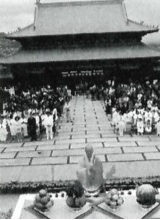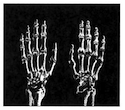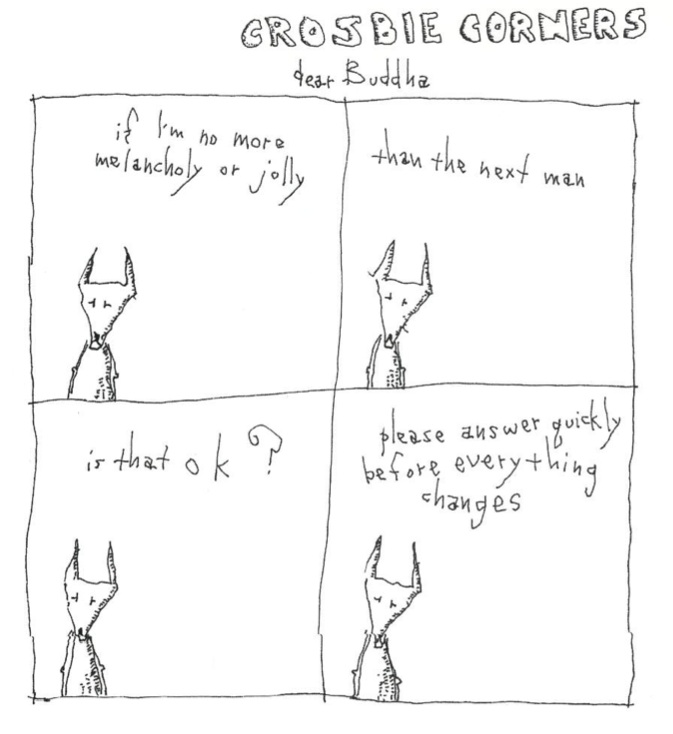Ordinary Mind
I really enjoy Tricycle. I love the intellectual awareness that the articles demand of me. I am always thrilled when Tricycle comes in the mail and always learn there is hope for my path, however vague or cluttered it may become. The dharma is truth—that much I know.
I am wondering whether others are out there too. I am a poor Buddhist, live a simple life and try to pay my bills. I’d like Tricycle to include me in your magazine—stories about regular folks out there working away and trying to follow the path. The Ph.D.s stimulate my intellect, but I could use a hero or two!! Thanks for listening.
Jane Hilton
Tucson, Arizona
Bad Company
 I don’t know if anyone has had a problem with the cover of your Fall 2000 issue, in which an image of the Buddha is included on Mt. Rushmore, but I want you to know that I had to remove it from my magazine. Every time I reached to pick up my copy I cringed to see Lord Buddha included in the company of Indian-killing presidents carved into a sacred mountain. If the issue of this cover’s insensitivity was not raised prior to publication, your editorial staff is sadly lacking in political awareness—an interesting paradox, considering the issue’s theme.
I don’t know if anyone has had a problem with the cover of your Fall 2000 issue, in which an image of the Buddha is included on Mt. Rushmore, but I want you to know that I had to remove it from my magazine. Every time I reached to pick up my copy I cringed to see Lord Buddha included in the company of Indian-killing presidents carved into a sacred mountain. If the issue of this cover’s insensitivity was not raised prior to publication, your editorial staff is sadly lacking in political awareness—an interesting paradox, considering the issue’s theme.
Julie Crow
Indianapolis, Indiana
The Fall 2000 cover of Tricycle is most unfortunate. The presidential carvings into Mt. Rushmore are a desecration of that mountain which is sacred to the Lakota peoples. Surely this is not a place for the Buddha, even by an artist’s sleight of hand! An apology to the Lakota peoples would be in order. I am sure this was an oversight on your part, and that had you been aware of this the cover would not have appeared. I often enjoy the many fine articles in Tricycle and thank you for its publication.
Bettina Aptheker
Soquel, California
The Real McCoy
I am an ordinary practitioner in the Nyingma tradition of Tibetan Buddhism, who—like tens of thousands of students around the world—is gradually working his way through the foundational teachings, practices, and transmissions that lead to Dzogchen, the Great Perfection.
Lama Surya Das calls himself a Dzogchen lineage holder, yet embraces a casual “player-coach” teaching model that may or may not be valuable in other Buddhist traditions, but has no precedent in the transmission of Dzogchen (or tantra). Why should American students take a chance on an unproven experimental model when the real McCoy is readily available?
Sidney Skinner
San Francisco, California
 As a student of Tibetan Buddhism, I was very heartened by your interview with an American teacher of Dzogchen [Lama Surya Das]. Of all the Buddhist schools and lineages now operative in the West, this is certainly one of the most subtle and extraordinary, but also one burdened by a proprietary Tibetan leadership and a solipsistic definition of “pure practices,” many of which are simply no longer appropriate or useful for the larger non-Tibetan landscape of Vajrayana. The interview left me with many questions and concerns, but I applaud his courage in trying to pour “old wine into new bottles.”
As a student of Tibetan Buddhism, I was very heartened by your interview with an American teacher of Dzogchen [Lama Surya Das]. Of all the Buddhist schools and lineages now operative in the West, this is certainly one of the most subtle and extraordinary, but also one burdened by a proprietary Tibetan leadership and a solipsistic definition of “pure practices,” many of which are simply no longer appropriate or useful for the larger non-Tibetan landscape of Vajrayana. The interview left me with many questions and concerns, but I applaud his courage in trying to pour “old wine into new bottles.”
William Kroll
Miami, Florida
Elective Affinities
Anne Jeffries expresses the view that “political engagement does breed an unholy attachment” and claims that “whether it helps or hinders the plight of the unblessed, the attachment itself leaves you imprisoned, your horizons diminished, and thwarts your ability to investigate without bias.” In her attachment to her own, apparently ego-driven, spiritual goals, Ms. Jeffries has forgotten the essence of Buddhist practice: compassion. It doesn’t take a bodhisattva to understand that each of us should do our part to alleviate the suffering of others and promote their health and well-being. To form a judgment about which political candidates will better serve those ends, and thus better enable everyone to follow a path with heart, is not the same thing as being judgmental or attached. When someone is hungry or sick or suffering, the “enlightened” thing to do is to feed and assist them, and voting is, in its own small way, a step that each of us should take to do just that. Ms. Jeffries’s obsession with her personal nonattachment, at the expense of everyone else’s welfare, is perhaps the most attached piece of writing I have ever seen in Tricycle.
Lisamichelle Davis
Chicago, Illinois
 I think there is racism inherent in the partisan value of the Hsi Lai temple video, and I’m tired of hearing Buddhism smeared. But how did this get rolling? Your two articles glossed over the blatant corruption of a major Buddhist institution. How did a center of the largest Chinese monastic community wind up using its nuns as tools to launder big-time illegal political contributions? Who owns this place, and how do the spiritual, the secular, and the seamy intersect there? Mr. Niebuhr cites the temple’s reluctance to talk about the issue as evidence of “profound fatigue” and says nuns now have “more important things to do, like propagating the dharma.” Mr. Leong’s woolly article asserts that “you don’t get a sense of lingering corruption” when you visit the temple today. After all the discussions of teacher ethics I’ve read inTricycle, I don’t know why this group’s leaders are getting a free ride.
I think there is racism inherent in the partisan value of the Hsi Lai temple video, and I’m tired of hearing Buddhism smeared. But how did this get rolling? Your two articles glossed over the blatant corruption of a major Buddhist institution. How did a center of the largest Chinese monastic community wind up using its nuns as tools to launder big-time illegal political contributions? Who owns this place, and how do the spiritual, the secular, and the seamy intersect there? Mr. Niebuhr cites the temple’s reluctance to talk about the issue as evidence of “profound fatigue” and says nuns now have “more important things to do, like propagating the dharma.” Mr. Leong’s woolly article asserts that “you don’t get a sense of lingering corruption” when you visit the temple today. After all the discussions of teacher ethics I’ve read inTricycle, I don’t know why this group’s leaders are getting a free ride.
Richard Genz
Asheville, North Carolina
In Gustav Niebuhr’s article the eminent historian of religions in America, Martin Marty, counters the suggestion that media attention to Al Gore’s fundraising improprieties at the Hsi Lai Temple is, in part, derived from anti-Buddhist sentiment. According to Marty, “We Americans can hardly be seen as massively anti-Buddhist when we find the Dalai Lama the biggest draw on every campus he can get to.”
How peculiar to articulate anti-Buddhist sentiment by suggesting that the Dalai Lama is strategically pushing to speak at “every campus he can get to.”
This is a very different statement than referring to the Dalai Lama’s popularity “on campus whenever he speaks.” Even more realistically, it’s quite different than referring to “every campus to which he is invited.” Perhaps Professor Marty’s assessment of the acceptance of Buddhism needs to start a little closer to home.
Gail Martino
Austin, Texas
Dem Bones
 In regard to Wes Nisker’s article “Evolution’s Body”, there are 200 bones in the body, not “over 600 separate bones,” as he incorrectly states. Also the “great bone of your skull” is in fact composed of 8 separate bones as well as 14 for the face. Please print this correction in your next issue so we can “get to know ourselves as biological beings” correctly. Thank you.
In regard to Wes Nisker’s article “Evolution’s Body”, there are 200 bones in the body, not “over 600 separate bones,” as he incorrectly states. Also the “great bone of your skull” is in fact composed of 8 separate bones as well as 14 for the face. Please print this correction in your next issue so we can “get to know ourselves as biological beings” correctly. Thank you.
Karen Price
Palo Alto, California
Nun of the Above
I was happy to note that so much mention was made of Buddhist nuns in the article “The Western Network” (Fall 2000). However, there were several errors in it that I would like to correct.
– Bhikshus are fully ordained male monastics and bhikshunis fully ordained female monastics, i.e., novice monastics (shramanera/shramanerika), and some other monastics (for example, Theravada nuns) are not included in those two categories.
– The full ordination for nuns (bhikshunis) was not denied after the Buddha’s teachings were codified. The ordination lineage spread to Sri Lanka, China, Korea, and Vietnam and has continued there uninterruptedly. It later died out in Sri Lanka. Novice ordination spread to Tibet. Neither bhikshu nor bhikshuni ordination exist in Japan, where the priests take a form of bodhisattva vows. They do not have the Vinaya monastic vows, which require celibacy.
– Sister Thanasanti is not a bhikshuni. Although she and the other Theravada nuns practice Vinaya very well, and they formally take precepts, they unfortunately are not even considered novices in the Theravada tradition, let alone fully ordained.
As you noted, there is now increased admiration for the monastic path. Nevertheless, much misunderstanding about it remains—oppressive patriarchy, sexual neurosis, and social dependence—as the article pointed out. In addition, some Western Buddhists have a certain degree of prejudice against the monastic life.
Ven. Thubten Chodron
Seattle, WA

Dear John Paul
I am delighted that William LaFleur’s insights about religious belief and contraception and his challenge to Pope John Paul II received public airing in Tricycle. The letter should be read by people of all faiths, since Buddhism clearly has much to teach every citizen of the planet about the religious and moral significance of procreation, population growth, and ecological health. Actually, my colleague R. T. Both and I tried to help in that effort when on the staff of the Park Ridge Center in Chicago. We succeeded in getting part of LaFleur’s message out in a publication of that research institute on health, faith, and ethics. But we were unable to include his whole text because senior administrators and editors didn’t appreciate the frankness of LaFleur’s analysis and challenge, which might offend religious hierarchies in Catholicism or other religious traditions. Yet it is exactly this kind of honest interfaith exchange that our interdependent world needs today: identifying what in our different faiths does not serve the common good as well as how we can learn from one another to advance that shared agenda.
Thank you for being a vehicle for facilitating this profoundly needed exchange.
Larry L. Greenfield
American Baptist Minister
Chicago, Illinois
I found the tone of William R. LaFleur’s letter to Pope John Paul II disrespectful and superior. I can’t imagine a Catholic addressing the Dalai Lama in this way. The term “fecundism,” which he apparently invented, is offensive as well as being grammatically suspect. By consistently using quotation marks when referring to Buddhist scriptures he gives the impression that in his view Buddhism is too lofty to call its sacred texts scripture. The Buddhism that comes across in this letter is cold indeed and, I hope, not a true picture of Buddhist compassion.
Could someone explain to me what is so ethical in Buddhists’ not celebrating the birth of a child?
Jean Vargas
Editor’s note: For continued discussion of this topic, visit the bulletin boards at www.tricycle.com.
Correction
Thank you very much for the informative and illuminating article about Colin Turnbull. However, I would like to make one correction. The article mentioned that Mr. Turnbull stayed at the ashram of Sri Aurobindo and his wife, The Mother. The Mother was not Sri Aurobindo’s wife, but his disciple and successor. Sri Aurobindo’s wife had passed away years before he started the ashram in Pondicherry.
Todd Chambers Email [We regret the error —Ed.]

